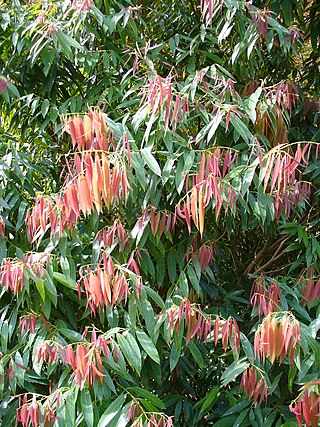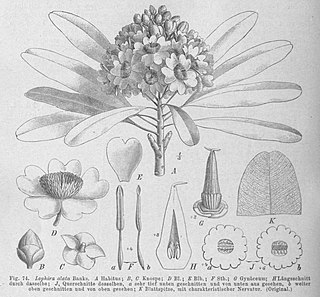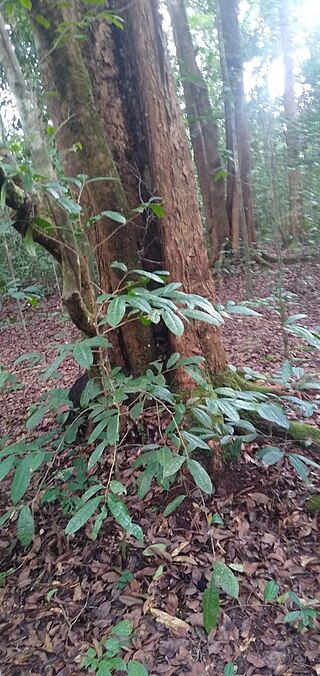
Mammea americana, commonly known as mammee, mammee apple, mamey, mamey apple, Santo Domingo apricot, tropical apricot, or South American apricot, is an evergreen tree of the family Calophyllaceae, whose fruit is edible. It has also been classified as belonging to the family Guttiferae Juss. (1789), which would make it a relative of the mangosteen.

Kigelia is a genus of flowering plants in the family Bignoniaceae. The genus consists of only one species, Kigelia africana, which occurs throughout tropical Africa. The so-called sausage tree grows a poisonous fruit that is up to 60 cm long, weighs about 7 kg, and resembles a sausage in a casing.

Barringtonia asiatica is a species of Barringtonia native to mangrove habitats from islands of the Indian Ocean in the west to tropical Asia and islands of the western Pacific Ocean. It is grown along streets for decorative and shade purposes in some parts of India, for instance in some towns on the southeastern shore. It is also known as Box Fruit due to the distinct box-shaped fruit it produces. The local name futu is the source of the name for the Polynesian island Futuna. The type specimen was collected by botanist Pehr Osbeck on a sandy beach area on the island of Java, later to be described by Carl Linnaeus in his Species Plantarum in 1753.

Celtis africana, the white stinkwood, is a deciduous tree in the family Cannabaceae. Its habit ranges from a tall tree in forest to a medium-sized tree in bushveld and open country, and a shrub on rocky soil. It occurs in Yemen and over large parts of Africa south of the Sahara. It is a common tree in the south and east of southern Africa, where the odour given off by freshly-cut green timber is similar to that of Ocotea bullata or black stinkwood.

Treculia africana is a tree species in the genus Treculia which can be used as a food plant and for various other traditional uses. The fruits are hard and fibrous, can be the size of a volleyball and weight up to 8.5 kg (19 lb). Chimpanzees have been observed to use tools to break the fruits into small pieces that they can eat. The fruits contain polyphenols.

Nagkesar oil is extracted from seeds of the nagkesar tree. It belongs to the Calophyllaceae family. It is an East Indian evergreen tree and is often planted as an ornamental for its fragrant white flowers that yield a perfume. It is the source of hardwood used for railroad ties. It is Sri Lanka's national tree.
Balanites wilsoniana is a species of fruit-bearing tree from west and central Africa from the caltrop family (Zygophyllaceae).

Lannea welwitschii is a species of tree in the family Anacardiaceae. It is native to the tropical rainforests of West and Central Africa. The timber is used to make furniture and utensils and for many other purposes, the fruits can be eaten, and the bark is used to produce a dye, for making rope and in traditional medicine.

Lophira lanceolata, commonly known as the dwarf red ironwood, is a species of tree in the family Ochnaceae which is native to tropical West and Central Africa. The timber is used for heavy construction, an edible oil can be extracted from the seeds and various parts of the plant are used in traditional medicine.
Ongokea is a genus of flowering plants, with one species Ongokea gore (Boleko). In the APG IV system, the genus is placed in the family Olacaceae. Other sources place it in the segregate family Aptandraceae.
Duguetia staudtii is a medium-sized evergreen tree within the Annonaceae family. Species is one of four within the genus Duguetia that is native to Africa.
Osodendron altissimum, formerly known as Albizia altissima, is a low branching tree within the Fabaceae family, it grows along river banks in the Lower and Upper Guinean and Congolian forests of west and central Africa.
Cynometra ananta is a perennial large tree within the Fabaceae family. Its timber is traded under the name Apome in Ivory Coast and Ananta in Ghana.
Gambeya africana is a medium sized tree within the Sapotaceae family. It is sometimes known as the African Star Apple along with the closely related Gambeya albida. Both species have similar leaf indumentum and are widespread in the Lower and Upper Guinea forest mosaic.
Anthonotha macrophylla is a shrub to small understory tree within the Fabaceae family. It is endemic to the rain forest regions of West Africa and it is the most common of species within the Anthonotha genus in Africa.

Berlinia grandiflora is a small to medium sized tree found in the West and West Central African region along riparian habitats or gallery forests habitat types.

Sacoglottis gabonensis, commonly known as bitterbark tree or cherry mahogany is a medium to large sized evergreen tree within the Humiriaceae family. It is the only species within the genus, Sacoglottis that is native to tropical Africa, another, guianensis Benth. being native to Amazonia. It occurs in rainforests or on sandy soils of Senegal eastwards to Angola in central Africa. It is traded locally and known in some countries under the name Ozouga.
Manilkara obovata is small to large sized evergreen tree within the Sapotaceae family. Its timber is sold under the name Nkunya in Uganda. The species has a wide distribution from Sierra Leone in West Africa moving east to Uganda in Eastern Africa and southwards to Zambia. It is also considered a variable species having different ecotypes.

Pentaclethra macrophylla, also known as the African oil bean, tree is a large size tree with long bipinnate compound leaves that is endemic to West and Central Africa. It is within the family Fabaceae. Seeds of the species are prepared and fermented to make Ugba, a soup condiment in Nigeria.
Entandrophragma angolense, called the tiama, is a tree species with alternate, pinnately compound leaves that are clustered at the ends of branches. It is within the family Meliaceae and has a wide distribution area, occurring in moist semi-deciduous and evergreen forest regions of Tropical Africa from Sierra Leone to Uganda.










